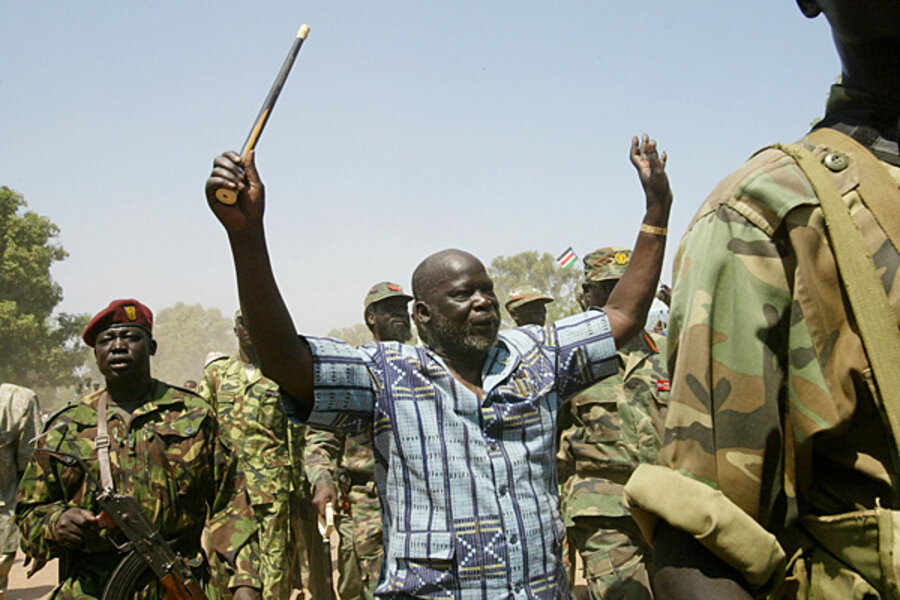Five years after death of John Garang, a divided Sudan wonders: What if?
Loading...
| Juba, South Sudan
Crowding the tops of the city’s roofs, vehicles, and trees, a sea of faces struggled to catch a glimpse of the US-educated African bush guerrilla.
John Garang de Mabior – the burly, coal-skinned Sudanese Dinka known simply as “Dr. Garang” to most of his followers – had arrived in Sudan’s capital, Khartoum, having signed a peace deal ending the two-decade rebellion he led in the nation’s marginalized south. Some one million turned out to greet him.
Less than one month later – on July 30, 2005 – the tenacious leader was Sudan’s new vice president, and dead. Five years later, the optimism spurred by the peace deal has largely faded and Sudan’s split appears imminent. A January 2011 secession referendum in the south is expected to result in either the country’s division, renewed war, or both.
Indeed, even the scene at Garang's grave today was starkly secessionist, with thousands of southern Sudanese gathering to pay vigil and wave southern Sudanese flags. Hundreds of southern police officers and troops marched in the streets of Juba.
Many still wonder: What if Garang had not died in a helicopter crash that fateful July day?
Africa’s largest country has always been one of its most troubled, plagued by peripheral rebellions since before its 1956 birth. Garang thought he had the cure. He called it the “New Sudan.” Democratic, secular, and united, Garang’s dream nation would share power and wealth across its vast landscape and diverse peoples, both Christians and Muslims, “African” and “Arab.” Sudan did not have a “Southern problem” or a “Darfur problem,” Garang argued.
He thought the nation had a rotten core which needed replacing. It was a task which was to consume his life.
From Sudan to Iowa to Ethiopia
Born in the south’s Jonglei state, John Garang’s path split early from his cattle-herding peers. A restless youth, he made his way to Julius Nyerere’s socialist Tanzania, where he received schooling alongside other future contemporary revolutionaries: Uganda’s Yoweri Museveni, Rwanda’s Paul Kagame, and the late Congolese leader Laurent Kabila.
He then left for the United States, where he found his way to Iowa’s bookish Grinnell College. The Midwestern state’s cattle and crops must have felt familiar; he later returned to earn his master’s and PhD at Iowa State University.
In 1983, with a flimsy 1972 peace deal collapsing, Garang was serving in the Sudanese Army. He and fellow Army conspirators mutinied, finding haven in neighboring Ethiopia, and for the next two decades he led the burgeoning rebellion – dubbed the Sudan People’s Liberation Movement – with iron-fisted determination.
By 2002, Sudanese President Omar al-Bashir’s National Congress Party was ready to negotiate. In the 2005 pact, Garang secured a coalition national government and key wealth-sharing arrangement for the south’s oil fields.
Without a unifier, divisions set in
Southern Sudan was granted regional autonomy – Garang as its president – leading up to a January 2011 referendum in which the south can choose to secede. Both sides promised to make unity “attractive” in the interim. Under Garang’s lead, SPLM – although southern-based – had officially stayed a unionist party, cultivating strong party structures across the north and the south. That all changed after his death.
According to Peter Adwok Nyaba, an outspoken member of SPLM’s top political body, the SPLM immediately fell into the hands of staunch separatists. The party, lacking Garang’s political skills and vision, began to weaken. “With the death of Garang, a power gap occurred in the SPLM and this was easily reflected in its engagement with the NCP and other northern parties,” Mr. Nyaba wrote last year.
When Sudan went to the polls in April, which saw President Bashir reelected president, north and south appeared more discordant than ever.
“Sudan is dividing,” said Pagan Amum, secretary-general of today’s SPLM, in an interview in the south’s capital, Juba, following Sudan’s April elections. “The winner Bashir with his Islamist agenda gives the south no option but to secede,” Amum said. “Unity has not been made attractive.”
'If Garang was still around...'
Noticeably absent from the list of challengers to Bashir was Salva Kiir, Garang’s longtime loyal deputy and default successor. Mr. Kiir, a life-long military man with little education, never appeared comfortable filling Garang’s role on the national stage. In April, Kiir ran to retain his regional presidency of Southern Sudan instead of aiming for the nation’s top seat.
Kiir’s decision followed a secessionist trend evident in the SPLM since Garang’s death, say analysts.
Today, among Southern Sudanese, “If Garang was still around...” is a phrase often heard privately, preceding criticism of the region’s lost political pull. Among aid workers, the phrase has become a sort of obligatory caveat to their litany of frustrations. In Juba’s expat-filled bars, the “what If” game abounds.
But whether a peacefully united “New Sudan” was ever possible is a question whose answer appears to have been buried along with Garang five years ago.
“Even while he was alive, many senior SPLM members were actually fighting for secession. The majority of people in the south have always been secessionists,” says John Ashworth, a long-time Sudan observer with close ties to the south. “After his death, it became clear that unity was not going to be given a chance."
Related:





